

Damion Smy
GWM Cannon Alpha ute, Tank 300 HEV and Tank 500 recalled
14 Hours Ago
Does the most luxurious, road-friendly LandCruiser 300 Series grade carve out a niche within the wider line-up?
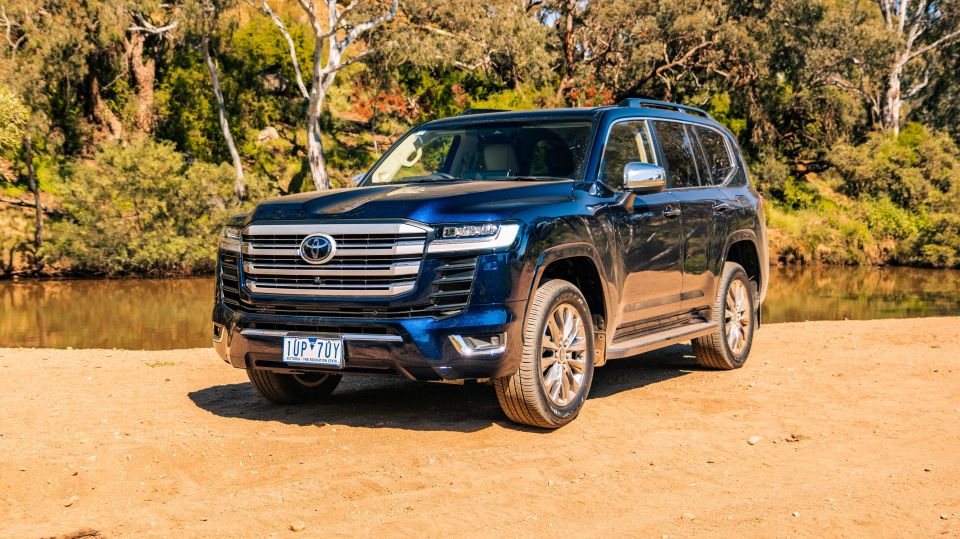


Quickly see how this car stacks up against its competition. Select any benchmark to see more details.
Where expert car reviews meet expert car buying – CarExpert gives you trusted advice, personalised service and real savings on your next new car.
Another week, another review of the Toyota LandCruiser300 Series.
This one is the luxury Sahara ZX grade, which builds on the already luxurious ‘base’ Sahara and sits atop the range alongside the more rugged GR Sport variant which we reviewed and filmed separately, here.
With unique features such as a rear limited-slip diff, adaptive damping, and 20-inch alloy wheels with reduced tyre sidewall, the Sahara ZX looks the most on-road-biased ‘Cruiser.
In other words, it strikes me as Toyota’s attempt to beat Lexus at its own game, and even get people thinking twice about that new Land Rover Discovery or other premium European 4WD.
There are six spec levels of the newest LandCruiser, all aimed at different types of buyers.
The GX workhorse variant kicks off at $89,990, climbing to $101,790 for the volume-selling GLX, to $113,990 to the more luxurious VX, to $131,190 for the opulent Sahara.
Where the 300 Series moves the game on over its predecessor is in the presence of two range-toppers: the extra-hardcore GR Sport version at $137,790, and finally the ‘sportier’ luxury flagship Sahara ZX sampled here at $138,790.

All of these prices are RRP, meaning they exclude State-specific on-road taxes and dealer delivery charges. The Sahara ZX’s quoted drive-away price on Toyota’s homepage using a Melbourne postcode is $152,036.
That’s a big chunk of a change for a ‘Cruiser, and ongoing supply constraints mean you’re as likely to get a discount as you are to see a 300 Series flying at 30,000ft on its own steam.
Watch our for dealers capitalising on the supply versus demand equation with demo-model price markups, otherwise known as gouging. I saw one selling a ‘used’ model with 5km on the odometer in WA, for $192,990…
MORE: 2022 Toyota LandCruiser 300 price and specs
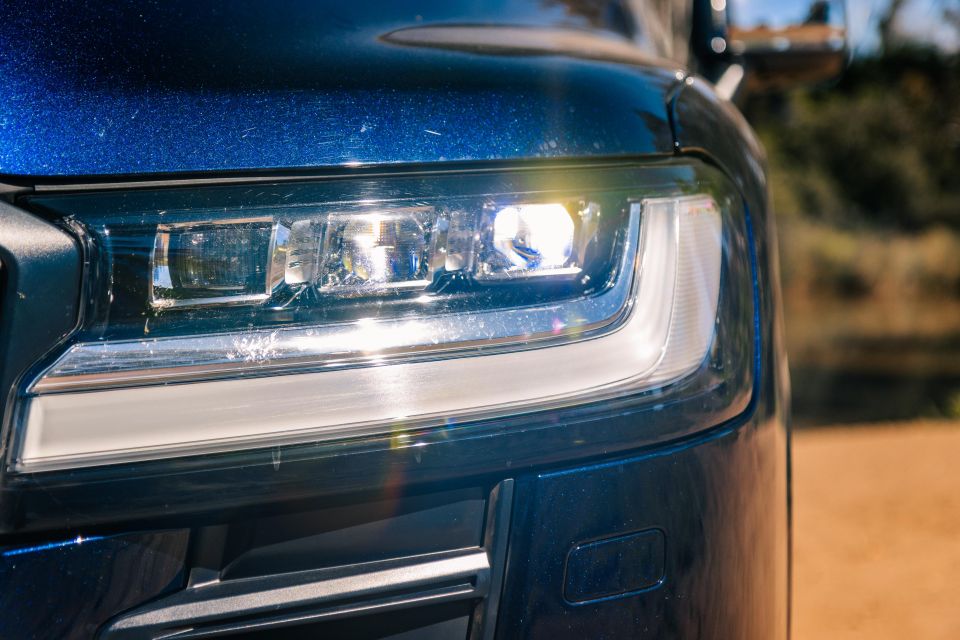
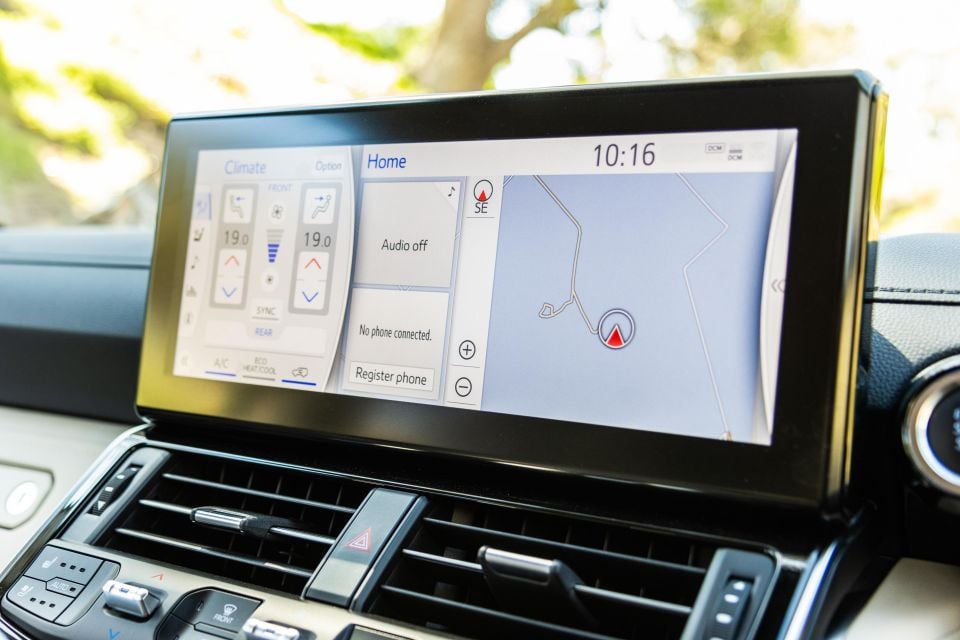
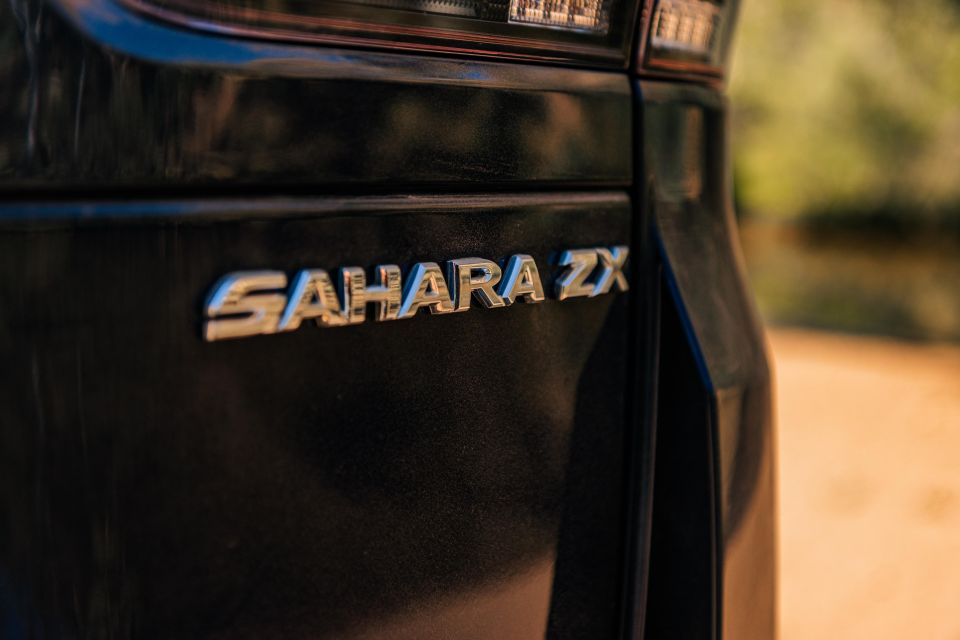
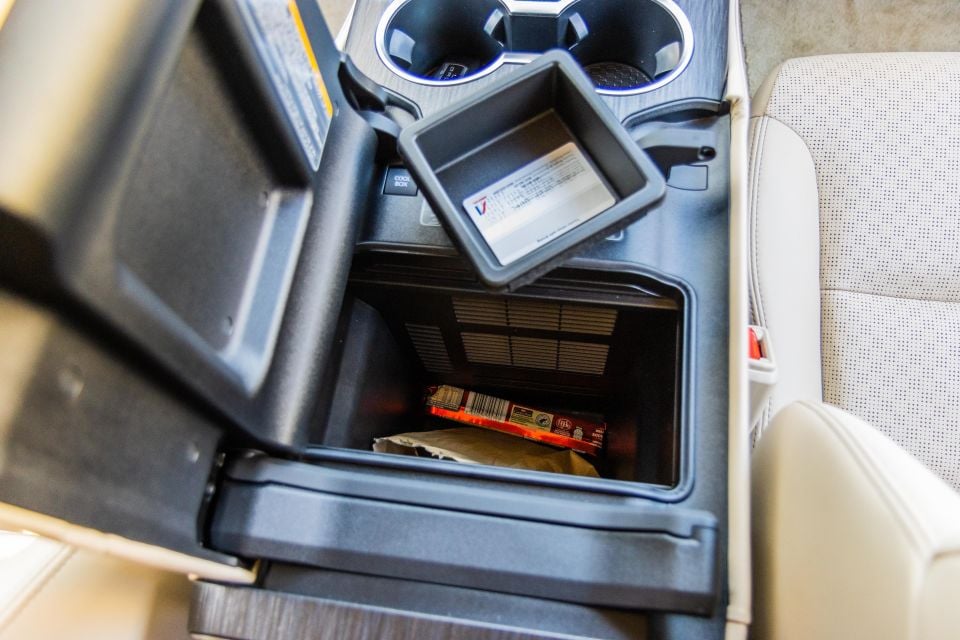
Buy your new car without the stress. It's fast, simple and completely free.

Great service from Travis and team, second time I have used this business would not hesitate to recommend them to anyone
Craig C.
Purchased a Ford Ranger in Sunshine Coast, QLD
CarExpert helped Craig save thousands on his Ford Ranger, now let us save you on your next new car.
Find a dealUnique features on the Sahara ZX over its lesser siblings include a rear torque-sensing LSD, adaptive variable suspension, five drive-select modes rather than three, 20-inch wheels, different interior trims, and an adaptive high-beam system.
Design-wise it offers what Toyota calls “a graceful and purposeful bodykit worthy of a flagship”, with a different front lower bumper design (with approach angle trade-off), polished wheels, and chrome and body-coloured trims.
Otherwise it shares much with the LandCruiser Sahara, with both offering a lengthy feature list as shown below.

Outside – Sahara and Sahara ZX
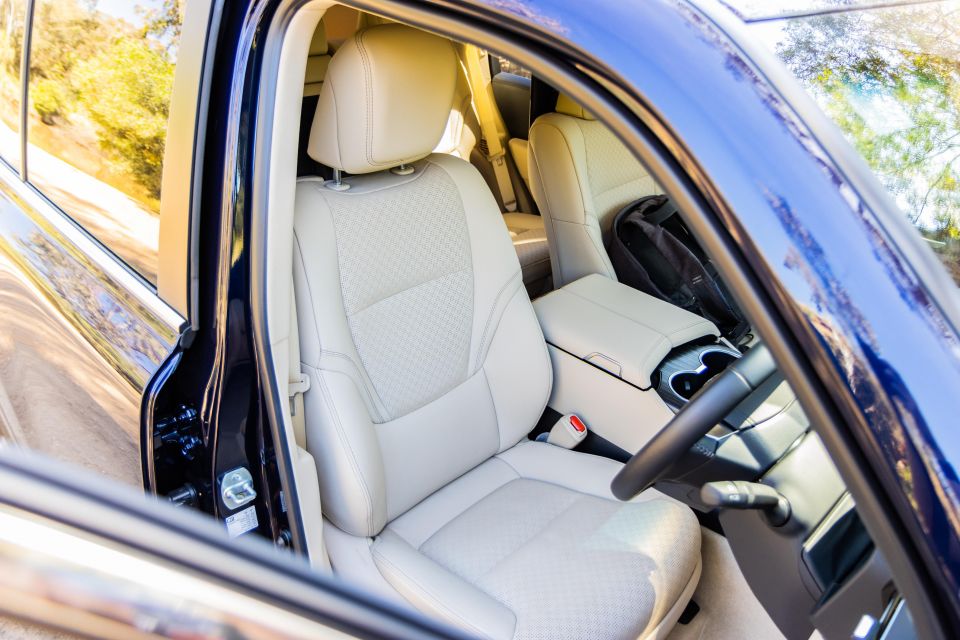
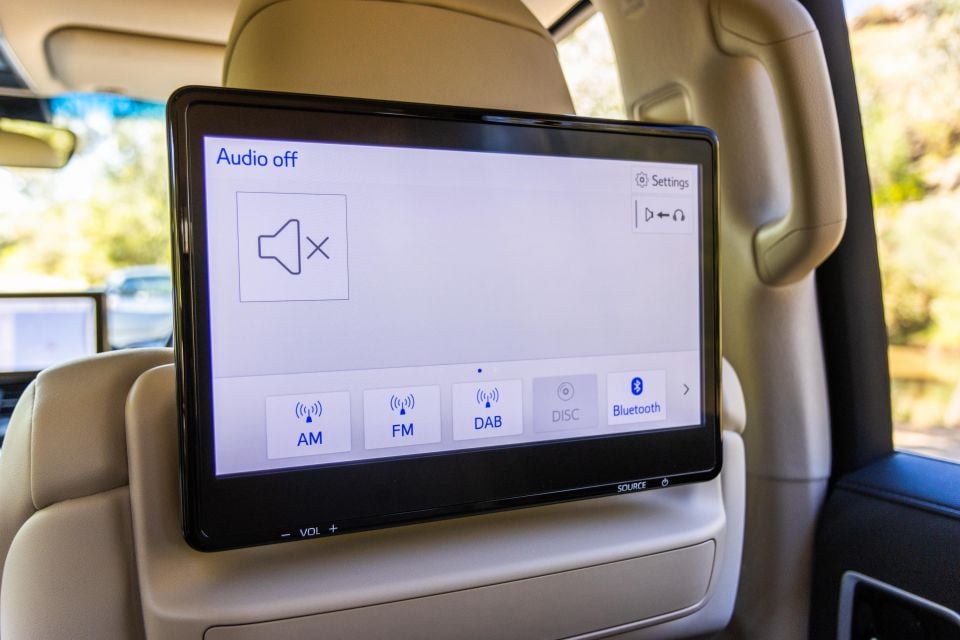
Inside – Sahara and Sahara ZX
There are 10 colours to choose from. Our tester’s metallic dark blue looked great in the sun.

The new LandCruiser was the first vehicle in 2022 to score the maximum five-star ANCAP crash rating, excluding the GR Sport grade which the brand deemed insufficiently high-volume to bother submitting the requisite data over.
The burly beast nabbed 89 per cent for adult occupant protection and 88 per cent for child occupant protection – though a lack of child-seat points in third-row models was noted – plus 77 per cent for safety assist driver aids.
Despite being so big and bluff, it also scored a good 81 per cent for vulnerable road user protection – the second-best score to date under the latest test protocols active since 2020.
MORE: Toyota LandCruiser 300 Series earns five-star ANCAP safety rating
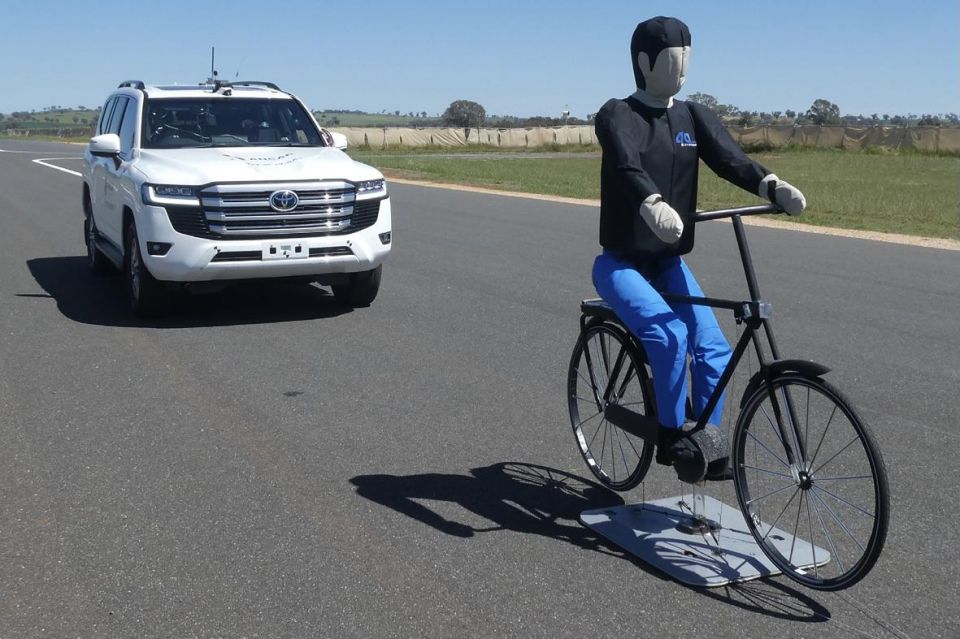
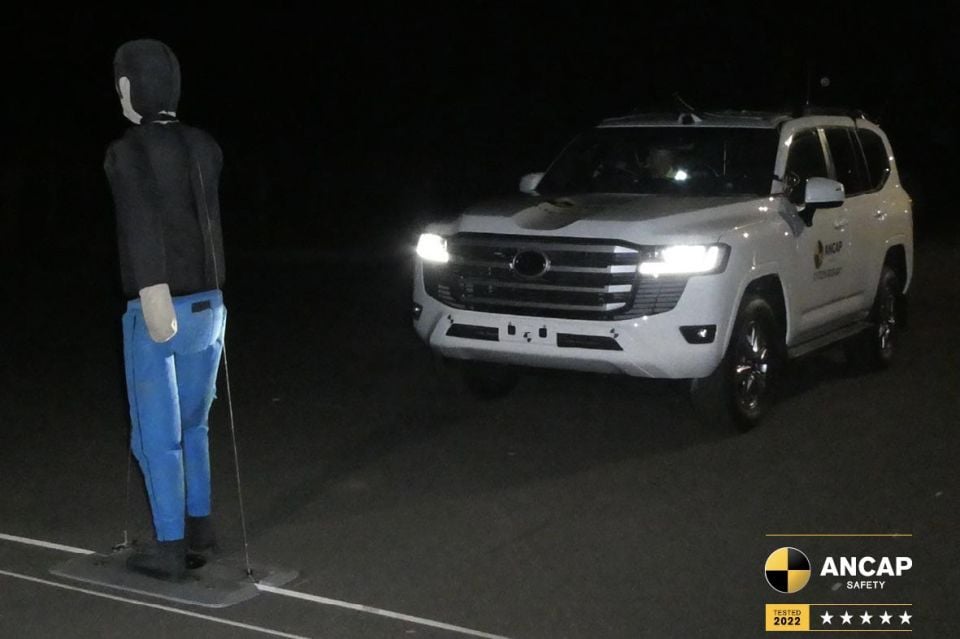
Standard safety features include:
The lane-keeping aid uses brake pulsing and steering vibrations rather than steering intervention.

In some ways a step forwards (interior technology, BMW-like metallic trims), and in others reassuringly familiar (solid-as-a-rock quality, ease-of-use).
The generous side step and A-pillar handles make climbing in pretty simple, and the light cream leather seats feel supple, are nicely cushioned, better-bolstered, and come with heating, cooling, powered movement and driver-side memory functions.
The steering wheel adjusts using a small electric motor and a tiny joystick-type button, has nicely damped switches and buttons to control various driver-assist and audio functions, and is finished in quality stitched leather with ‘carbon-look’ trim inserts – in my opinion, preferable to the regular Sahara’s darkish woodgrain trim.

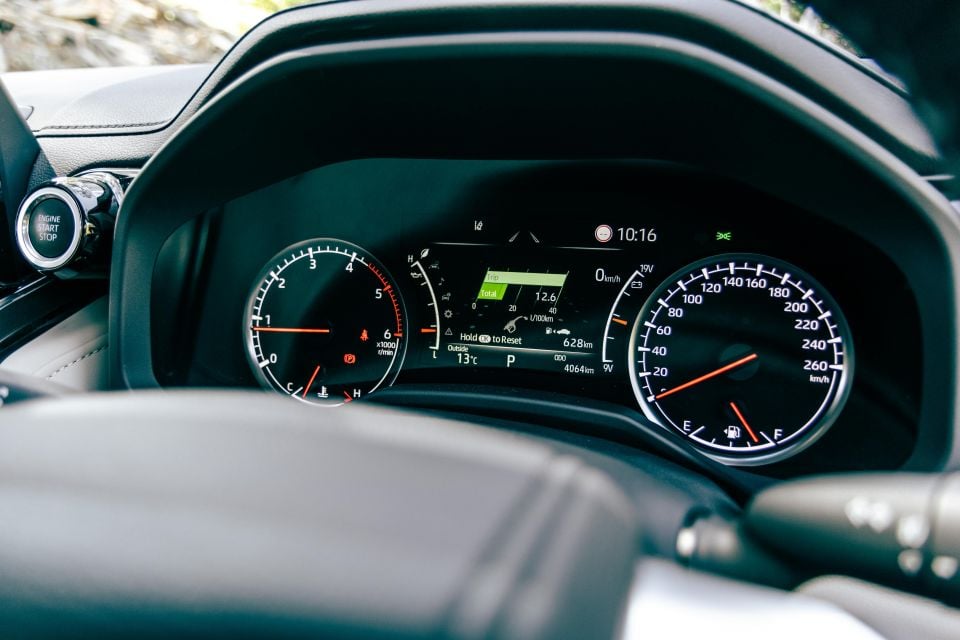
Behind the wheel are clear analogue speed and tacho gauges with a battery voltage meter too, flanking a large central digital information meter through which you can control or monitor trip data and various safety and infotainment functions.
You can view a digital speedo therein, but you’re better off relying on the head-up display that projects onto the windscreen, unsurprisingly reminiscent of a Camry’s. It all adds up to a commanding and easy-to-situate driving position with plenty of information easily found.
Clearly the colour pattern inside was not designed for hardcore bush-bashing. Cream leather is matched by similarly coloured carpeting, as well as light-coloured lower dash, console and door trims. Best of luck keeping this free of scuffs, though it’s good in the Aussie summer.
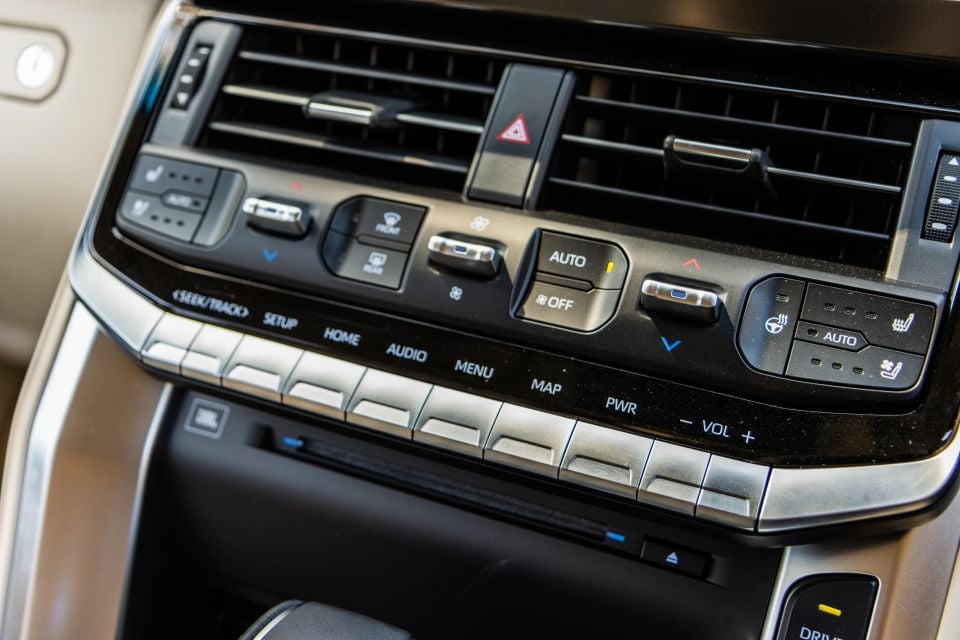
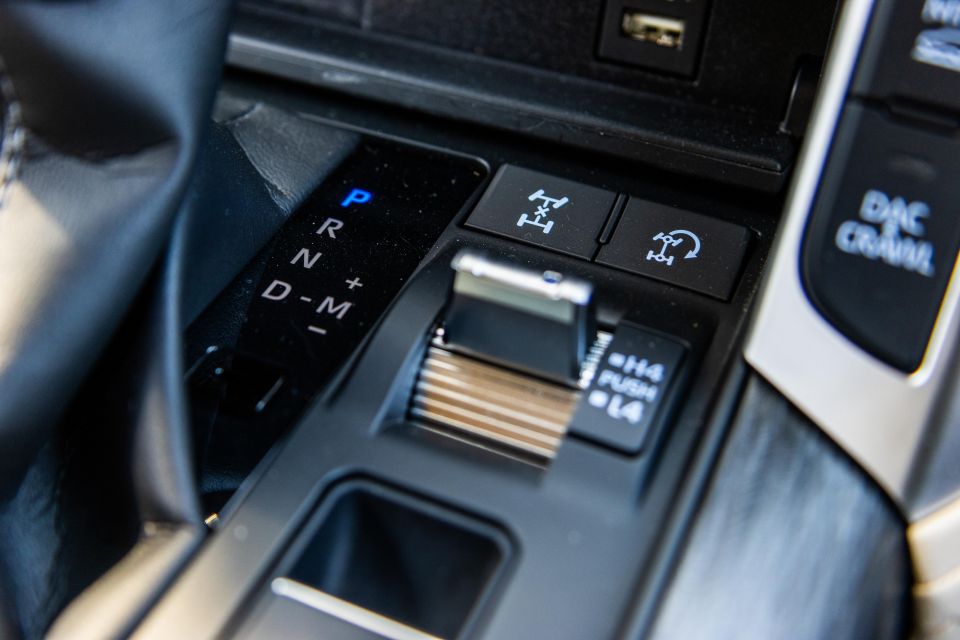


From a usability perspective I’m glad Toyota didn’t make every interface a touchscreen or the haptic pad thing so in vogue with luxury brands.
There are big buttons, rocker switches and knurled dials everywhere to control core functions such as air-conditioning, various driver aids, off-road controls, and audio functions – all with clear labels, creating less faffing about on the move. The ‘old’ ways are sometimes also best.
There’s a wireless charging pad, as well as the requisite USBs front and rear, 12V and 220V (the latter three-prong socket lives in the cargo area) inputs, and Bluetooth streaming. But there’s also a CD player, which is a novelty in a new vehicle these days.
The navigation system is the default for some, but I tend to turn to Apple CarPlay or Android Auto phone mirroring – if only it could be programmed to take up the full screen width for extra clarity.

The 12.3-inch touchscreen takes up plenty of real estate and offers simple-to-understand blocky home menus and shortcut buttons. But in terms of graphics and processing it behaves like cheaper Toyotas – just on a swisher display. Good enough for a $150k+ vehicle?
By the way, be sure to watch the embedded video above for a deeper look at the menus, particularly the helpful if slightly grainy overhead-view camera display.
The 14-speaker JBL sound system offers better sound quality than lower-grade LandCruisers, and since it’s already a quiet vehicle, there’s real crispness and clarity on the move.
You’re relatively well-catered for when it comes to storage, with a big glovebox, slim door bins (no room for 1.5L bottles), friendly centre cupholders with subtle height adjustment and teeth, and of course the signature console with chiller box. Alas, it’s pretty small in the 300.
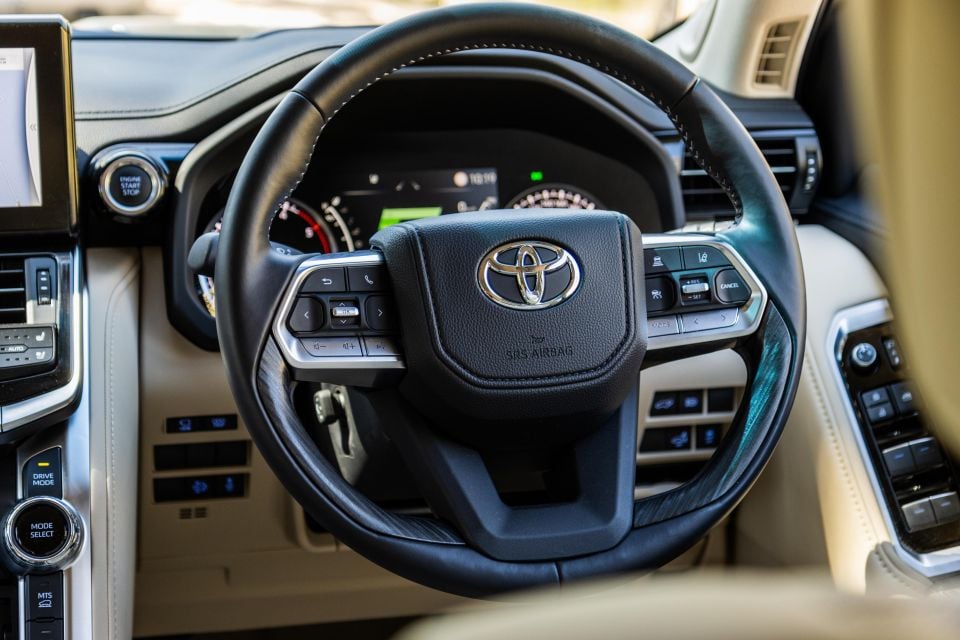
In short, there’s absolutely nothing revolutionary or likely to startle more conservative buyers, and while it’s more utilitarian than breathtakingly stylish, it does manage to feel solid and premium in a very ‘Toyota’ fashion.
The stowable (folding/tumbling for extra cargo space) second-row seats feature a reclining function and 92mm more legroom than before despite the familiar wheelbase. The centre section also folds down, giving you easy through-access from the rear.
There’s adult-friendly space and plenty of glass to makes seeing out simpler, although toe room below the font seats could certainly be improved.
Amenities back there include vents with two-zone climate controls, heated and cooled outboard seat bases, two USB inputs, 12V and HDMI plugs, and dual tilting 11.6-inch touchscreen displays.
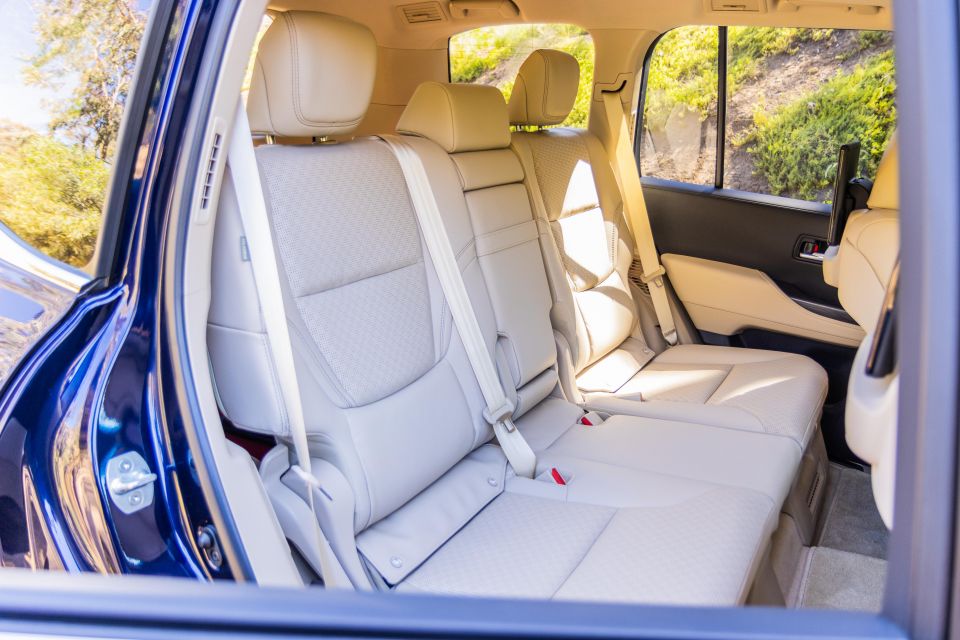

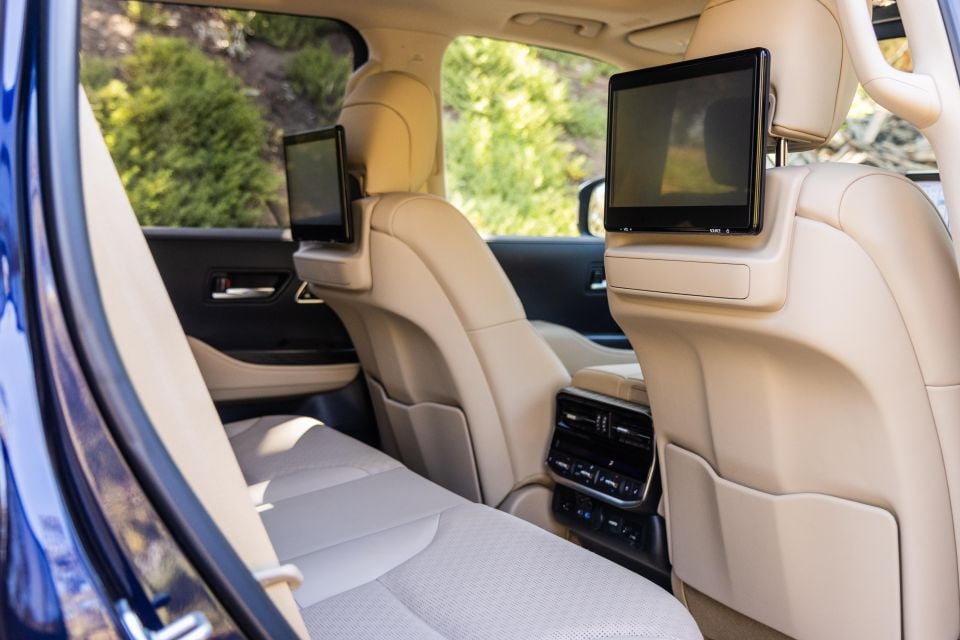
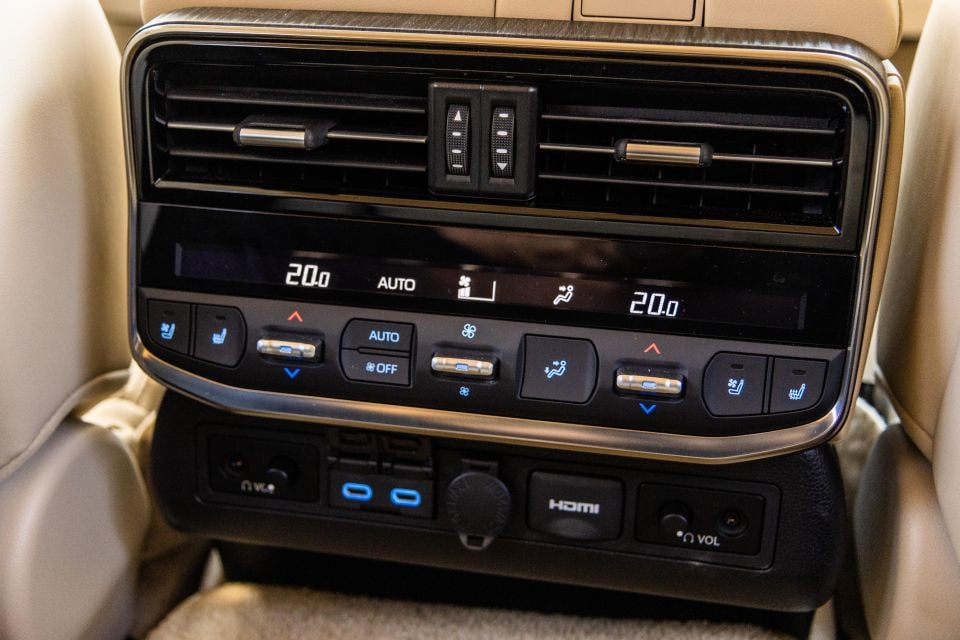
Two different modes are available on the back-seat information setup, with front-rear interlocking mode allowing the same content to be played for the front and rear seats, with sound available through both the speakers and headphones.
Independent mode allows different content to be played for not only the front and rear seats, but the individual screens. Along with WiFi-powered phone mirroring setup, the screens can also be wired through a 720p HDMI input if you prefer.
You’d think Toyota could install a full panoramic sunroof/moonroof though, not just a conventional front-seat-oriented one.
While the GXL, VX and Sahara package in a third seating row, the Sahara ZX is only a five-seater, which strikes me as a little unusual. What if you want to carry the grandkids and the kids? The presence of grab handles and roof vents in the cargo area shows that it was designed as a three-row vehicle, too.
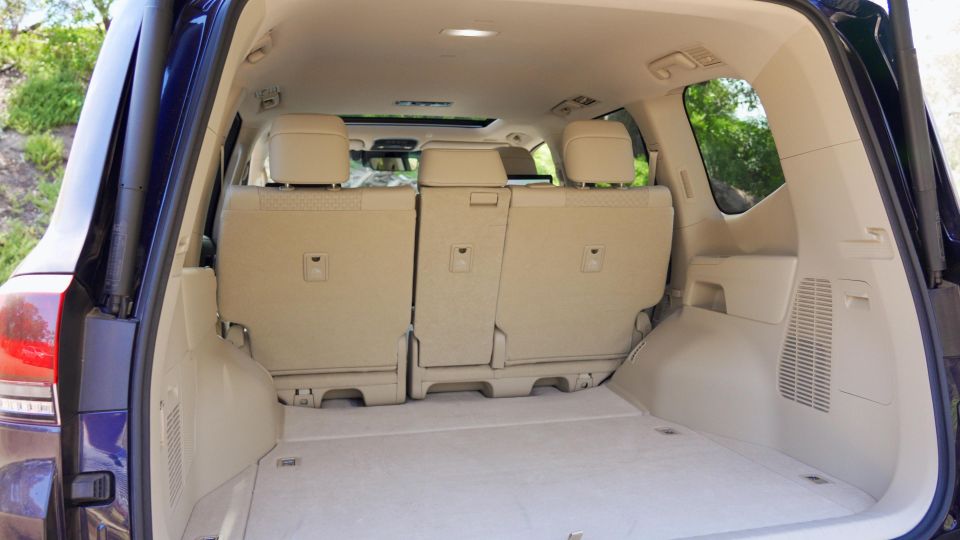
Where expert car reviews meet expert car buying – CarExpert gives you trusted advice, personalised service and real savings on your next new car.
| Length | 5015mm |
| Width | 1980mm |
| Height | 1950mm |
| Wheelbase | 2850mm |
| Clearance | 235mm |
| Seats | 5 in this grade |
| Cargo to roofline | 1131L |
| Back seats folded | 2052L (1150mm high) |
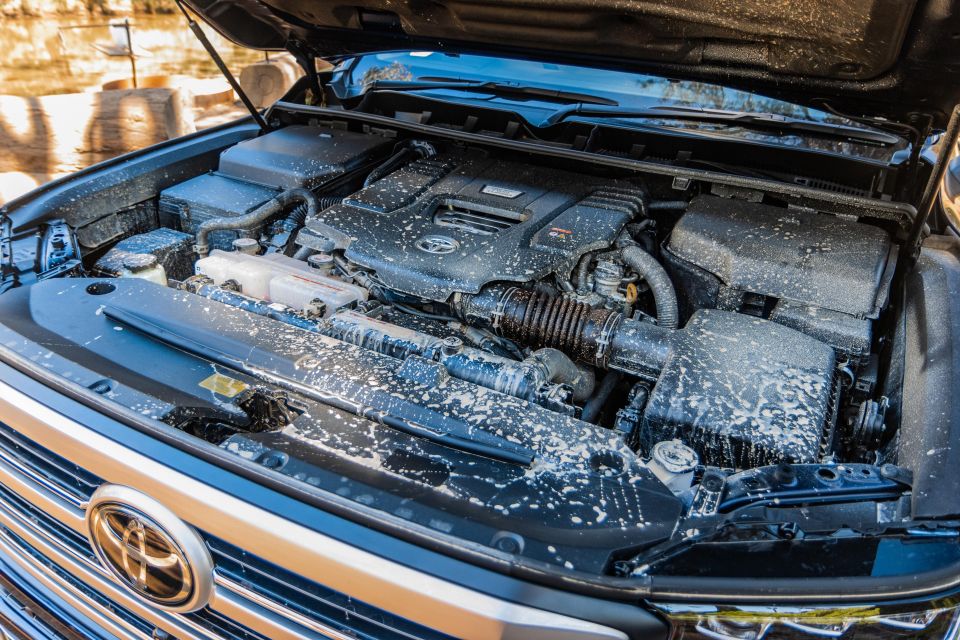
Power in the LandCruiser 300 comes from a 3.3-litre V6 twin-turbo diesel making 227kW of power and 700Nm of torque, the latter on tap between 1600 and 2600rpm.
The primary turbocharger is initially engaged and as engine speed increases, the second turbocharger is activated – at around 2600rpm to be specific.
Although it’s down 1200cc and two cylinders on the outgoing LandCruiser 200, the new engine has 27kW and 50Nm more.
It retains a 3500kg towing capacity with a braked trailer, and while its 6750kg gross combined mass is 100kg less than in the LC200, this new model is at least that much lighter.
The standard transmission is a 10-speed automatic, and full-time four-wheel drive with a centre differential lock is standard, and low-range that engages a claimed 28 per cent faster.
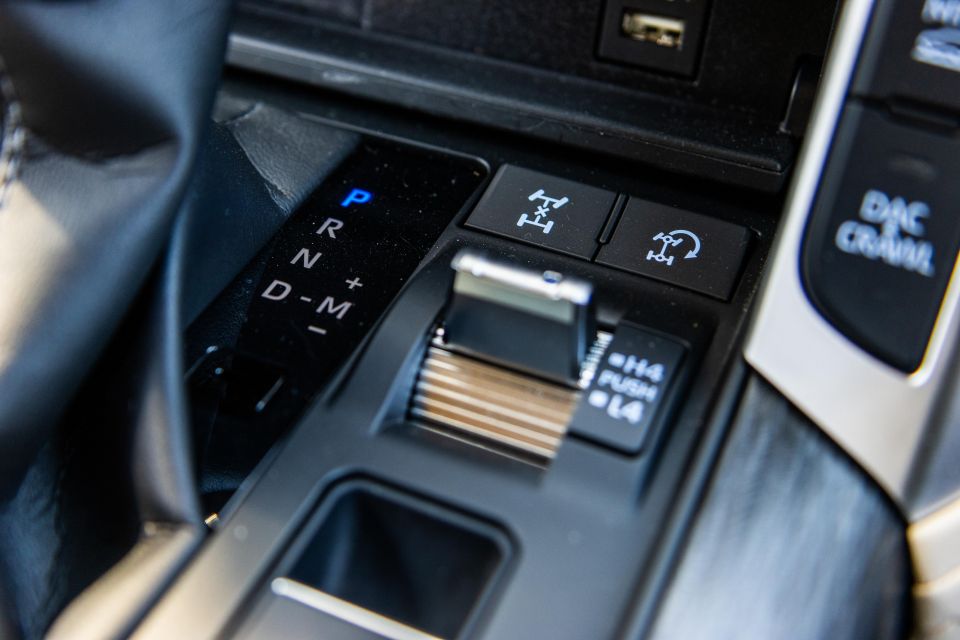
Combined-cycle fuel consumption is an ambitious ADR-rated 8.9 litres per 100km (down a claimed 6.3 per cent on the V8), climbing to 11.3L/100km in urban driving.
There are two fuel tanks: an 80L main tank and a 30L subbie.
The diesel particulate filter comes with a forced burn-off switch like the HiLux if you aren’t getting the vehicle up to the optimum operating temperature normally.
“The LandCruiser 300 Series’ all-new engine and transmission combination will ensure the performance, durability and reliability demanded by LandCruiser owners to take them across the harshest environments in the world, and back again,” Toyota claims.
Of course, the proof of that claim will come with time and miles.
| Engine | 3.3-litre twin-turbo V6 diesel |
| Power | 227kW @ 4000rpm |
| Torque | 700Nm @ 1600-2600rpm |
| Transmission | 10-speed automatic |
| Driveline | Full-time AWD with low-range |
| ADR economy claim | 8.9L/100km, 110L capacity |
| Towing capacity | 3500kg |
| Kerb weight | 2610kg |
| GVM | 3280kg (670kg payload) |
| GCM | 6750kg |
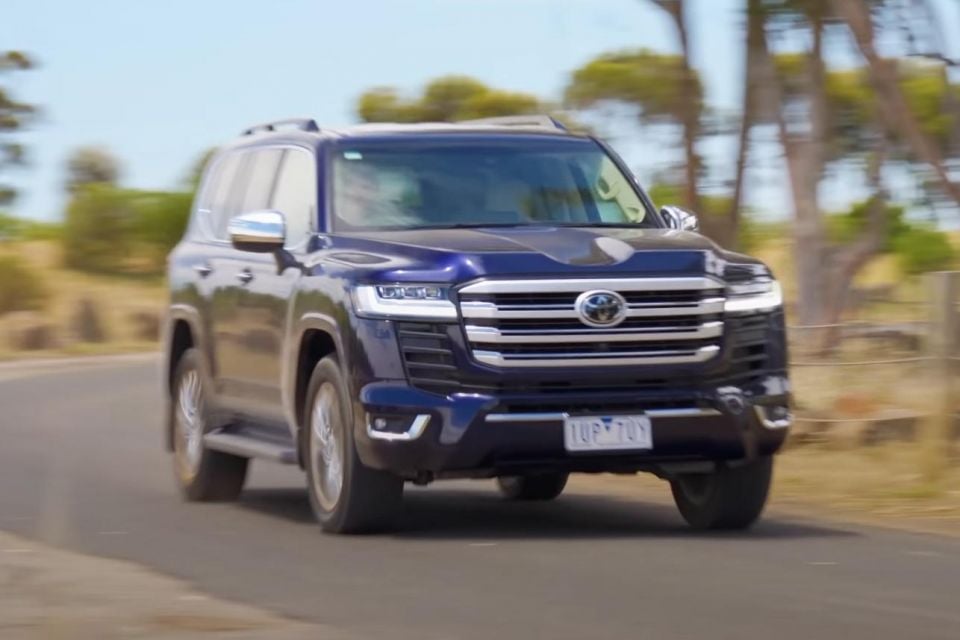
Toyota stuck with pretty familiar underpinnings but the new ladder-frame platform brings weight savings up to 160kg. It’s a more wieldy and rigid take on a proven formula, down to the wheelbase carryover.
It also conducted its most expensive local tuning program to date, racking up tens of thousands of kilometres at its Melbourne testing centre and all over the most remote corners of the country. Australia’s contributions to the global program were well-noted.
The major query point is of course the engine, a brand-new twin-turbo with 10-speed auto.
While we can’t really get a gauge on long-term reliability, we can certainly attest to its effortless low-speed punch, lack of lag, sonorous note, and well-tuned auto that rarely hunts around despite its stacked ratios. There’s a lesson for the Ford Everest in here…
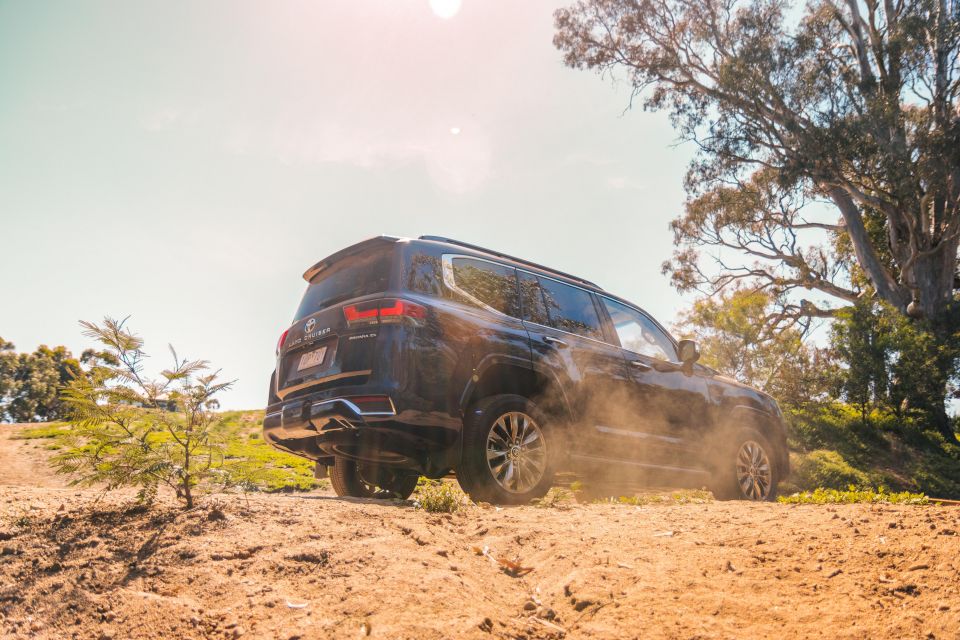
There’s no official 0-100km/h claim, but we did the dash in 8.96 seconds – pretty pokey for such a big beast.
My average fuel use was 11.7L/100km, which is a fair way from the ADR claim. Yes it’s not as thirsty as the growly old V8, but not by all that much to be honest. Which is not to say it isn’t a much punchier and more engaging technical solution.
Of course, if you’re towing you’ll see this spike – but that 110L dual-tank capacity endures generous range so you won’t be stuck between roadhouses.
Three drives modes are offered as standard as all LC300s – Eco, Normal and Sport – that adjust the throttle, transmission and steering parameters. Eco mode can also reduce the output of the air conditioner for extra fuel savings.
The Sahara ZX and GR Sport add Comfort and Sport S+ settings too, with further fine-tuning of the throttle, steering and transmission – as well as the suspension, the latter being good news given the ZX has less tyre sidewall thanks to the bigger alloys.
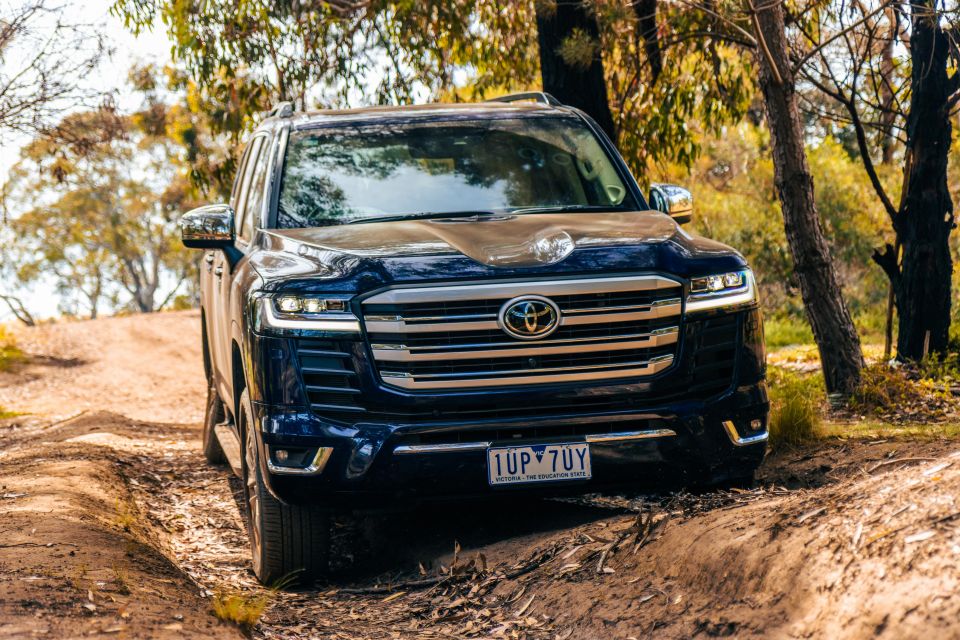
We found it to be impressively cosseting and smooth over all manner of Aussie B-road classics: gravel, corrugations, undulations, cattle grids etc. You can add a little stiffness to the damping if you want, for a little more body control, but it doesn’t suit the vibe really.
The Sahara ZX’s torque-sensing rear LSD is an interesting addition in a 2500kg-plus, high-riding, frame-based off-roader, isn’t it?
The Cruiser’s steering is unusual: a weightier and slower hydraulic steering rack with electric assistance, which means the lane-keeping aid has to pulse the brakes rather than turning the steering itself.
This is a case of sticking to convention with 4×4-ers in mind, but that doesn’t really make sense on the road-biased ZX grade quite as much. Perhaps I’m out of step.
The AWD system is permanent and variable, but there’s a locking centre diff. If you want cool extras such as detachable bars, and front and rear lockers, then you need to go for the GR Sport grade. The trade-off in the GR is its extra body roll as our video shows.
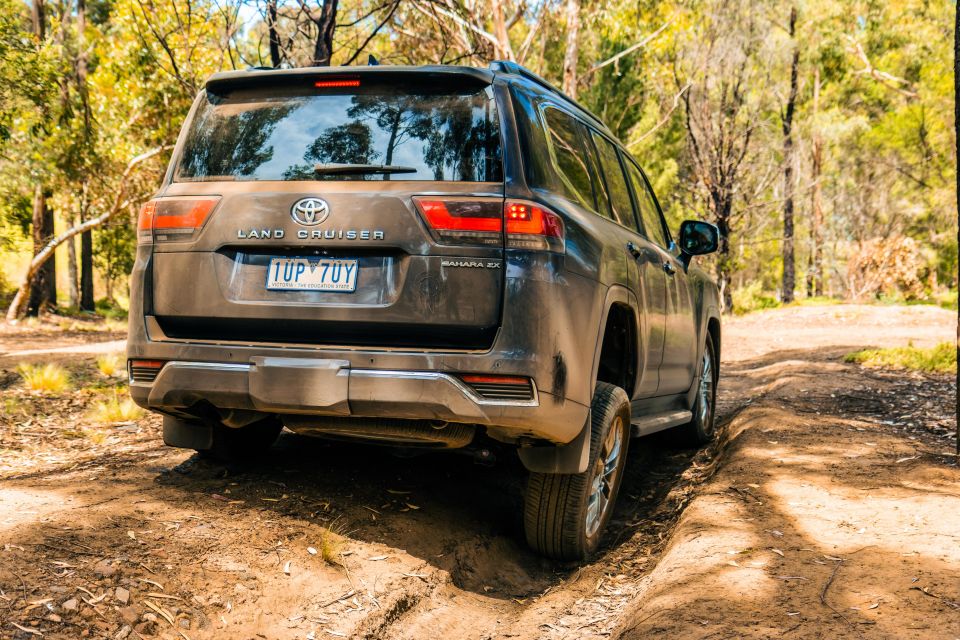
While the Sahara ZX isn’t designed for off-roading quite as much (the 8-degree reduction in approach angle due to the frontal design and road-oriented wheels attest to that), it’s still no urban soft-roader.
As well as 235mm clearance and a 700mm wading depth, there’s a low-range transfer case activated by a rocker switch on the tunnel, as well as adjustable downhill crawl control and multi-terrain select which changes the throttle response and ESP parameters on different low-traction surfaces (for example, Mud mode relaxes the stability control and collision alerts).
Toyota offers a 4×4 accessories catalogue as long as your arm, and so too will the aftermarket, though some features such as the TMC light bar were not designed for the Sahara ZX grade.
In terms of smoothness and compliance, transmission tune, engine braking, and outboard visibility (aided by the tricky cameras), and helpful TFT displays, it remains great off the beaten path – it’s just that the Sahara ZX is less off-road-ready than all the other grades.
By the way, the ‘turn assist’ button uses selective wheel braking to slash the turning radius when you have the diff locked.
One criticism: we made note of a strange knocking noise from the front steering areas, which we detailed more here, with response from Toyota. The other potential issue is the lack of a rear locking diff as standard because great articulation doesn’t always cut the mustard.
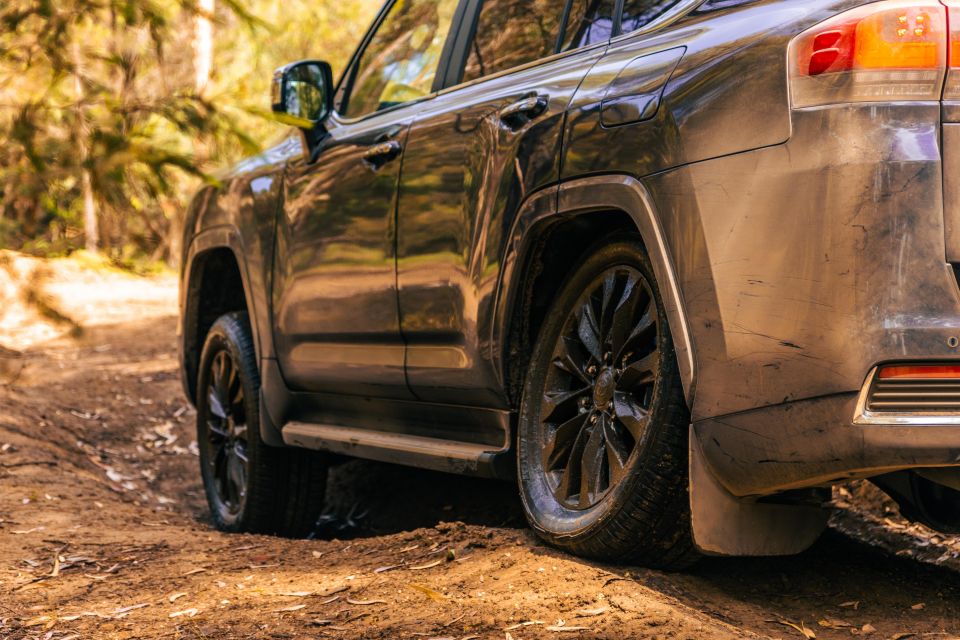
| Front brakes | 354mm ventilated, 4-piston calipers |
| Rear brakes | 335mm ventilated, 1-piston caliper |
| Steering | Rack-and-pinion hydraulic, with electric actuator |
| Turning circle | 11.8m, 3.05 turns lock-to-lock |
| Front suspension | Double wishbone, stabiliser |
| Rear suspension | Four-link, rigid axle |
| Adjustable suspension settings | Eco, Comfort, Normal, Sport, Sport S+ |
| Tyres | Bridgestone Dueler AT 265/55 R20 |
| Lockable diffs | Centre only |
| Torsen LSD | Standard |
| 4×4 traction modes | Auto, Dirt, Sand, Mud, Deep Snow, Rock |
| Clearance | 235mm |
| Approach | 24 degrees (other grades offer 32 degrees) |
| Departure | 25 degrees |

The LandCruiser is backed by Toyota’s five-year, unlimited-kilometre warranty.
‘Toyota Service Advantage’ covers capped-price servicing for the first 10 services at a cost of $375 each. Intervals are every six months or 10,000km, whichever comes first. That’s still shorter than the majority of vehicles on sale, with 12 months the new norm.
Owners will be able to extend their warranty on the engine and driveline to seven years by sticking to the service schedule, Toyota says.

For the first time, the Toyota Connected Services function is available in a LandCruiser.
TCS can automatically generate an emergency call to a 24/7 Toyota emergency call centre and relay the location of the vehicle, in the event of a collision reasonably requiring intervention or where an airbag is deployed.
Occupants can also manually trigger the SOS emergency call function, and if the vehicle is reported stolen, the system can help authorities locate the vehicle through the stolen vehicle tracking feature.
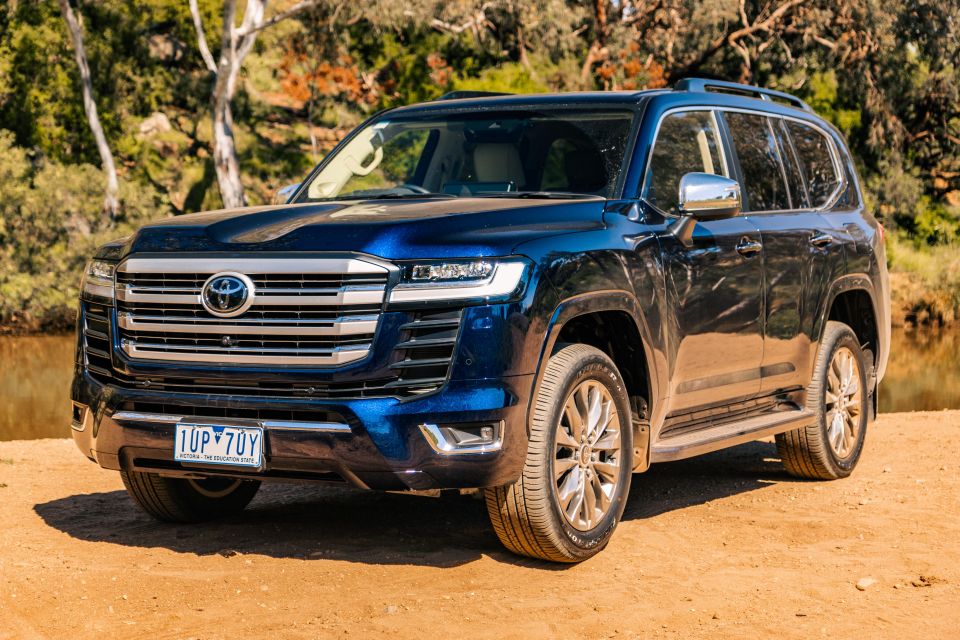
Underneath these relatively minor spec differentiators, the new ‘Cruiser felt to this writer to be a solid evolution: it modernises the formula without changing too much, as feels appropriate. It’s still the first luxury 4WD you’d take across Australia, though maybe not in this spec.
The challenge for this Sahara ZX variant is that, for all its unique attributes, it falls between the regular Sahara – which better-balances off-road capability and luxury to my eyes – and the GR Sport co-halo that outguns it for brashness and off-road attributes.
Its particular on-road and dynamic focus will certainly appeal to some, I suppose, and it remains highly capable. Perhaps Lexus and Range Rover buyers may even give the most luxurious and ‘sporty’ (I say that phrase in relative terms) a look-in?
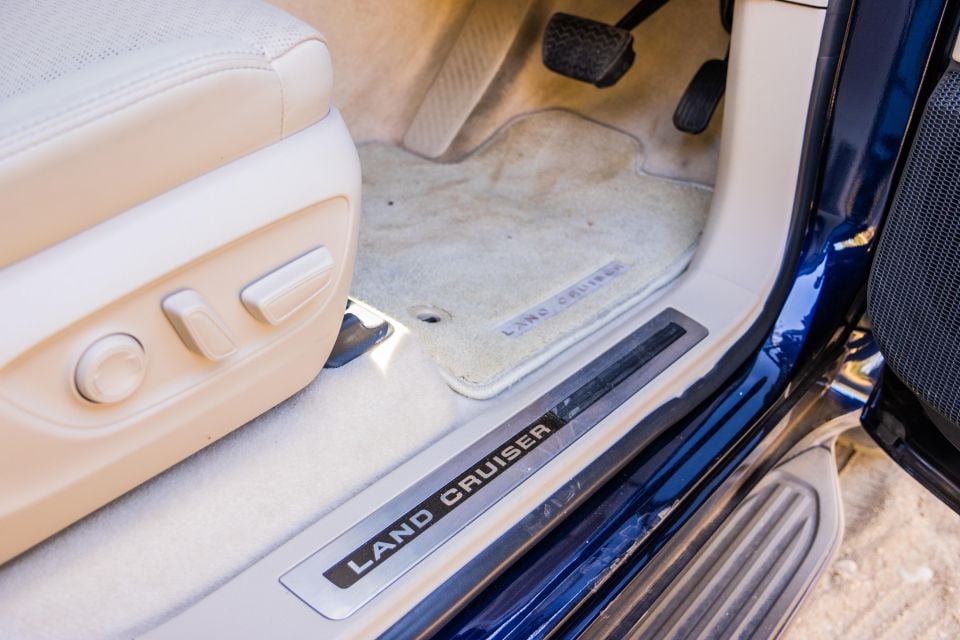
Click the images for the full gallery
Where expert car reviews meet expert car buying – CarExpert gives you trusted advice, personalised service and real savings on your next new car.


Damion Smy
14 Hours Ago


Josh Nevett
4 Days Ago


CarExpert.com.au
5 Days Ago


Damion Smy
7 Days Ago


Derek Fung
7 Days Ago


Ben Zachariah
10 Days Ago